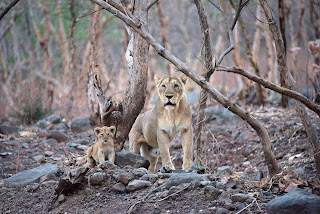Railway tracks and trains - A threat to the safety of Asiatic lions.

Railway tracks and trains also pose a significant threat to the safety of Asiatic lions in India, especially in the Gir Forest National Park and surrounding areas. Here are some of the ways railway tracks and trains can impact the safety of these endangered lions. Collision Mortality : Lions are at risk of being hit by trains while crossing or walking along railway tracks. The high speed of trains makes it difficult for lions to escape in time, leading to collisions that can result in injury or death. Habitat Fragmentation : Railway tracks can fragment the lions' habitat and disrupt their movement patterns. This can isolate lion populations, leading to reduced genetic diversity and increased vulnerability to diseases and other threats. Barriers to Movement : Railway tracks act as physical barriers that can restrict the movement of lions and other wildlife. This can lead to limited access to food, water, and suitable habitats, affecting their overall survival and well-being. H...



